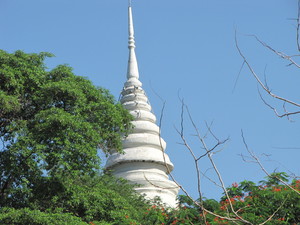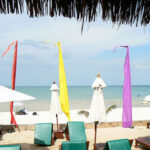Tourists often pass over the southeast Asian country of Cambodia, heading instead to its more “popular” neighbors, Vietnam, Thailand and Laos. If you’re seeking an unusual spring vacation destination, keep Cambodia in mind.
The nation’s warm, white sand beaches, busy cities, lush national parks and ancient temples offer the perfect backdrop for a unique spring break. In fact, more than 2.5 million tourists visited Cambodia in 2010, an increase of more than 1300 percent since the end of the country’s bloody 30-year-long war in 1993. Today, visitors can experience the region’s scenic beauty, learn about Cambodia’s rich history at its many temples and explore the vibrant culture in its cities.
Catch a glimpse of the Irrawaddy dolphins before they disappear for good. At one time, more than 1,000 of these rare mammals made their home in the Mekong River, but as of 2011, there are only about 75 left. The best place to see these beautiful creatures is the northeastern town of Kratie.
Just south of Phnom Penh, Preah Monivong National Park — also known as Bokor National Park — is home to 300 species of birds and endangered species, from Asiatic bears to elephants to tigers. This vast expanse of evergreen rainforest — 982 square miles to be exact — has a visitors’ center and an extensive trail system. It’s important to stay on the paths, as parts of Preah Monivong may contain landmines.
Some of southeast Asia — and the world’s — most important archeological sites are in Cambodia. You won’t want to miss the World Heritage site known as Angkor. Angkor Archeological Park, the former seat of the Khmer Empire that ruled Cambodia for more than 600 years, contains more than 248 square miles of ruins, including the world-renown Temple of Angkor Wat and the Bayon Temple. The region was once home to the city of Angkor, which at its peak in the 12th century, housed more than 75,000 citizens and 1,000 shrines and temples.
Contrast these ancient temples to the working temples of today. Visit the city of Battambang and head to the city center, where Wat Kandal, Wat Damrey Sar and Wat Phiphétaram house active monks. Plan on visiting the temples in the afternoon, when resident monks may be available to answer questions.
Schedule a few days to explore Phnom Penh; Cambodia’s capital city is home to palaces museums and markets that offer a glimpse into the region’s rich culture. Start at the Royal Palace. Home to the king, parts of the massive complex are open to tourists, including the Temple of the Emerald Buddha, the Chan Chhaya Pavilion, the Throne Hall, and the Silver Pagoda which contains thousands of silver tiles and religious artifacts.
Also in Phnom Penh, the collections at the National Museum of Cambodia hold a range of artifacts and art that document Khmer culture with an emphasis on religious pieces representing Buddhism and Hinduism.
No springtime trip would be complete without a day at the beach for swimming, snorkeling, diving and sunbathing. Head to the Koh Kong Conservation Corridor on the southwestern coast. This protected region encompasses Botum Sakor National Park, Koh Kong Island, Southern and Central Cardamoms Protected Forests and Peam Krasaop Wildlife Sanctuary. Most of the beaches in this area are undeveloped, though some resorts are popping up along the stunning white sand coasts.
Ministry of Tourism; Tourist Statistic Reports; May 2011
UNESCO: Angkor
National Museum of Cambodia
Ministry of Tourism Cambodia: Beaches




